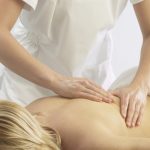Kyphosis (Humpback) and Massage
It’s a terrible condition and one that plagues many people from an early stage in their life. The muscular strain brought on by Kyphosis can cause a chronic condition of muscular tension. The good news is that Kyphosis is preventable and should be treated as early as possible. Here, I’ll discuss in simple terms how massage therapy or manual manipulation can play an important role in the restoring the damage that Kyphosis brings on.
What is Kyphosis
For too many, it’s an embarrasing condition that leaves an exaggerated curve in the spine. In the case of thoracic kyphosis, the shoulders are rounded forward and your spine takes shape of a hunch. It is what medical professionals call a postural malformation of the spine.
The spine is created from vertebrae, which are the individual bones that stack one on top of the other forming your very strong spinal column. Impressive and healthy curves that people have in their spinal column is not only normal but helpful. Beautifully designed, each natural curve was created in the spine to help with each twist and turn of the human body bearing its weight perfectly with gravity and assisting us from simple to very complex movements.
Unfortunately some people carry problematic issues with their bones either causing them to be fragile, others suffer from joint and cartilage pain early on and some are susceptible to bone misalignment. Children are particular prone to spinal misalignment due to developing bones, poor posture from perhaps being too tall and being teased in school. When girls begin to develop their bodies during puberty this may also cause them to hunch forward due to a feeling of self consciousness.
These bad habits indeed may form serious problems in the future for many people. Another population that suffers greatly from Kyphosis are those that are a taller height than most. Those who are young (specifically teenagers) may find that they don’t welcome their tall frame and as a way to hide might contort their body in subtle ways cause malformations of the hips and spine that might be hard to reverse when older.
Avoiding Surgery: A Natural Option
Depending on the severity of the disfigurement the conventional treatment prescribed for Kyphosis can be pain medication and or surgery. But a more natural approach is normally done within a physical therapy setting however a massage therapist that is well skilled and have clinical training could be of great benefit. The term “Kyphosis” is rarely something I see people check off in a massage intake form, however what they will claim is constant pain and tightness in the middle to upper back. To the massage therapist this is a vital clue that Kyphosis might be an issue before a physical evaluation.
In a massage session, the muscles are treated for high levels of tension due to structural abnormalities. Although Kyphosis is a bone related problem, the muscles are affected becoming tight and strained from being pulled and force to sustain each vertebrae in a way it was never designed to. Therefore for a long lasting result and effective treatment of Kyphosis it’s imperative that the muscular tension is released.
How Muscles Work
When seeking treatment for any structural and functional issue, it’s important for the massage therapist to have a deep understanding of Kinesiology and spine anatomy. Beginning a massage for Kyphosis it may seem the most logical to begin with the muscles of the back, however I’ve discovered that beginning with the muscles of the chest area creates an ease in treating back muscles later in session. In Kinesiology there is a perfect balance in muscles, one side is the antagonist and the agonist. Below we have an example in the arm. Think of your bicep muscle (front of the upper arm) as the primary muscle and your triceps (located in the back upper arm)as the “helper” if you will. Normally these muscles exist on the opposite side of your body. So if you have a curve in your upper back, the muscles of your chest will be affected. If the muscles of your inner thigh are injured or sore in some way, most likely the muscles of your outer thigh will be sore as well. The antagonist muscles in Kyphosis (your chest) will not be as sore, but they will be affected to some degree.
Chest Muscles
Stretch The Chest
Correcting bad posture takes time and lots of patience. Another very important aspect in giving home therapy for Kyphosis is the stretching of the chest muscles. The more the person suffering from Kyphosis does this at home and consistently , the faster they will see the results. I recommend stretching the chest and shoulders for 7-10 minutes a day. Below is an example of a firm support cushion utilized to expand the chest and help with Kyphosis. This is just one of many ways to stretch out your muscles. Depending on the age of the person, some cases of Kyphosis may not completely be reversed however any relief of severe tension and much needed comfort would help the person live without so much discomfort. That is worth any discipline in stretching, massage and exercise.
Back Massage
Now that the chest muscles have released their tension through massage, the rest of the time may go to the muscles of the back. Covering areas like the trapezius muscles, rhomboids (between the shoulder blades) and infraspinatus (muscles covering the shoulder blades) prove to be very valuable. Of course, there are many layers of deep muscles that I don’t cover in this post but I touch on the most important. Below is a diagram on other muscles of the back that benefit from massage for those with Kyphosis.
The Neck
A common area that is easily overlooked are all of the neck muscles. Because the shoulders are rounded forward the head is most likely in a forward posture causing a lot of extra strain. The human skull along with all its attachments weigh 10-11 pounds. That’s a lot of extra work your neck muscles are doing if your head is not aligned. Now, please be aware of the sensitivity of the cervical region and choose a therapist confident in working with neck injuries. When done well, massage in the front,back and even sides of the neck muscles can provide immense relief.
Additional Therapy
Heat pads and stretches may be applied at home to release muscle tension in the areas mentioned above. When ready, a series of corrective exercises may prove to be very beneficial as your learn to strengthen all the muscle we’ve covered in this post. It is essential that these muscles are strong and that you’re educated on how to strengthen them to prevent further damage. For some with a family history of Kyphosis these exercises it may be a lifelong commitment.



